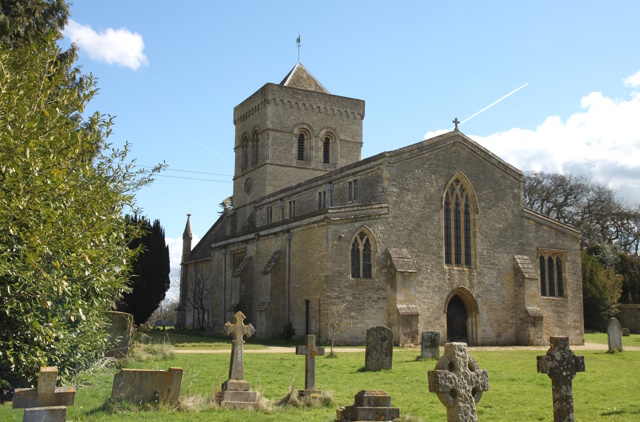


























St. Mary's Church, Kirtlington
The aisled nave of three bays was built in the mid-13th century. The north aisle had a doorway, now blocked, and a 13th-century piscina shows that the chapel of St. Mary on the south side of the tower was built at the same period. Some of the capitals of the nave arcade are decorated with foliage sculpture, and one of the hood-moulds terminates in the head of a woman wearing a nose-band. The east and west windows and the south and west doorways were inserted in the 14th century. The south porch and the clerestory were added in the 15th century. At the same time the wall of the south aisle, which had perhaps been pushed outwards by the original high-pitched roof, was rebuilt and given new windows. The pulpit is Jacobean. In 1661 six of the villagers were 'at the charge to beautify this church'. The work perhaps included the hanging of the royal arms over the chancel arch, where they remained until 1854. Sir Robert Dashwood, whose 'black' was buried in the chancel in 1691, converted the south transept into a family vault and chapel in 1716, the transept then being ruinous. The wrought-iron gates bearing the Dashwood arms are said to have come from Northbrook House. He also constructed a gallery across the west end (1726). In 1757 the church needed extensive repairs. In 1761 'the parish church of Kirtlington having of late been very ruinous, as well in the body and structure, as in the pews, and other parts of the inside thereof, Sir James Dashwood 'repaired, new-pewed and decorated' it at his own cost. In 1770, however, the tower was pulled down as unsafe. Sir James Dashwood's legacy of £300 for its rebuilding was not taken up (1779), and the church was without a tower for 80 years. Between 1852 and 1854 the church was restored, partly at Sir George Dashwood's expense. The work included the building of the present tower (architect Benjamin Ferrey), the erection of internal and external buttresses to support the wall of the north aisle, the removal of the gallery and the old square pews, paving with Minton tiles, and the installation of a new font. In 1877 the chancel was very thoroughly restored by Sir G. Gilbert Scott at Sir Henry and Lady Dashwood's expense. Some further restoration was done in 1891 and 1905. Wall-paintings of St. George and St. Christopher, which were rediscovered in 1905, are mainly of the late 15th century. The organ was placed in the Dashwood chapel in 1877; since about 1839, when 'the old Church band of clarinet and bassoon' had been done away with, singing had been accompanied by a barrel-organ. The organ obscures a monument, made by William and Thomas Williams of Middleton Stoney in 1724, to many of the Dashwoods (including the first three baronets) on the east wall of the transept, a 13thcentury piscina in the south wall, and a number of hatchments. Brass plates in the south transept and chancel commemorate the 4th and 5th baronets. The earliest monuments are of the 17th century. An undated tablet in the north aisle commemorates Rowland Bennet, who acquired Bennet's Farm at Northbrook in 1605; three other 17th-century tablets to members of the Hall family are on the exterior of the south wall. The only 18th-century wall monuments, other than the Dashwood memorial, are to James Evans, described as regius satelles (i.e. a royal sergeant) (d. 1702), and Ralph Rawlins of Northbrook (d. 1725) and Mary his wife, who died at the age of 97. In the nave is a tablet to John David, Earl of Leven and Melville (d. 1913). There are also two tablets to 19th-century incumbents, both Fellows of St. John's: James Saunders (d. 1838) and James Guillemard (d. 1858). In 1552 the church owned a chalice, two copes, and four vestments, and there was a light with lands worth 1s. a year. A silver-gilt service, consisting of chalice, paten cover, large paten, pair of flagons, and an almsplate, were given by Sir Robert Dashwood in 1723. Nearly all the bells, and also the sanctus bell, date from 1718, when the original peal of five was increased to eight at the Dashwoods' expense. The parish registers earlier than 1800 have been lost, with the exception of one for the years 1558– 1699, and a register of marriages for 1754–1818. Historical information about St. Mary's Church is provided by 'Parishes: Kirtlington', in A History of the County of Oxford: Volume 6, ed. Mary D Lobel (London, 1959), pp. 219-232. British History Online http://www.british-history.ac.uk/vch/oxon/vol6/pp219-232 [accessed 14 February 2023]. St. Mary's Church is a Grade II* listed building. For more information about the listing see CHURCH OF ST MARY, Kirtlington - 1300872 | Historic England. For more information about St. Mary's Church see Parishes: Kirtlington | British History Online (british-history.ac.uk). |

